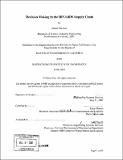Decision making in the HIV/AIDS supply chain
Author(s)
Cao, Elaine Phu
DownloadFull printable version (9.911Mb)
Alternative title
Decision making in the Human immunodeficiency viruses/Acquired immune deficiency syndrome supply chain
Other Contributors
Massachusetts Institute of Technology. Engineering Systems Division.
Advisor
Edgar Blanco.
Terms of use
Metadata
Show full item recordAbstract
During the first two decades of HIV/AIDS awareness, the U.S. and foreign governments responded slowly to the crisis. In contrast today, as the pandemic continues, initiatives of nonprofit organizations have dramatically increased the amount of available funding. Countries must work to effectively allocate the influx of resources. This paper examines one area for improvement within the context of the developing world: supply chain management. The HIV/AIDS supply chain in a resource-poor setting differs from traditional networks. In order to properly manage operational activities, it is important to understand inherent system complexities, such as bureaucratic funding, forced ordering, shrinkage, and human capital constraints. This research explores these issues and identifies five scenarios that impact performance measures. The model, developed through an integrated supply chain approach, simulates the effects of scenarios on inventory level, cycle service level, and missed treatment dosages. Supply chain planning without accounting for system complexities leads to significant drops in service performance from theoretical expectations. Countries should order excess inventory to compensate for these issues. (cont.) Funding efforts should focus on training resources to properly manage treatment demand and target operational changes that yield the highest improvements on performance metrics. Short-run and long-run tactics must be aligned to avoid the threat of widespread resistance, which results from inconsistent treatment and poor patient care. The goal of this research is to understand the HIV/AIDS supply chain and identify the best areas for resource investment.
Description
Thesis (M. Eng. in Logistics)--Massachusetts Institute of Technology, Engineering Systems Division, 2007. "June 2007." Vita. Includes bibliographical references (leaves 54-55).
Date issued
2007Department
Massachusetts Institute of Technology. Engineering Systems DivisionPublisher
Massachusetts Institute of Technology
Keywords
Engineering Systems Division.